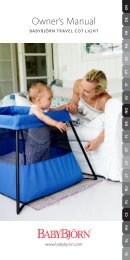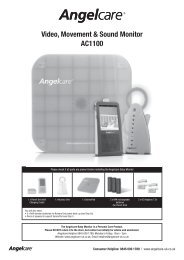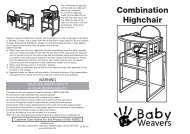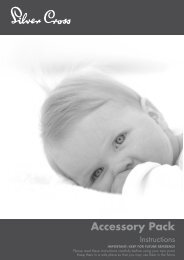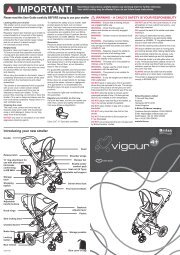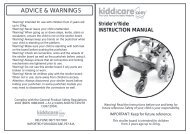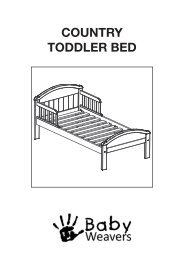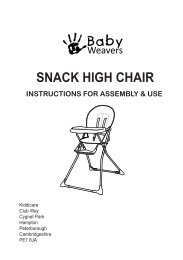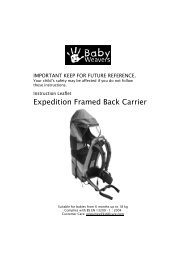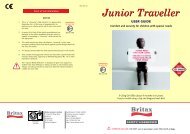1. Why Should We Use BabyPlus? 2. Is It Safe? - Kiddicare
1. Why Should We Use BabyPlus? 2. Is It Safe? - Kiddicare
1. Why Should We Use BabyPlus? 2. Is It Safe? - Kiddicare
You also want an ePaper? Increase the reach of your titles
YUMPU automatically turns print PDFs into web optimized ePapers that Google loves.
<strong>1.</strong> <strong>Why</strong> should we use <strong>BabyPlus</strong>?<br />
The real question is, "<strong>Why</strong> wouldn't you use <strong>BabyPlus</strong>?" <strong>It</strong> is safe, scientifically validated, and the benefits are<br />
remarkable. In order to give your child every advantage, you take care of your health while your pregnant - eating<br />
right, taking prenatal vitamins, avoiding alcohol, etc. <strong>Why</strong> not start educating your child as early as possible - with an<br />
age-appropriate curriculum.<br />
<strong>2.</strong> <strong>Is</strong> it safe?<br />
Yes it is. There is no question that this is an entirely new field of education, but prenatal stimulation has been around<br />
for thousands of years. <strong>BabyPlus</strong> simply represents the evolution of enrichment in the womb to a technique that has<br />
incredible advantages for the child. <strong>We</strong> believe that, someday, the use of <strong>BabyPlus</strong> will be as much a part of being<br />
pregnant as is taking prenatal vitamins.<br />
Decibel (dB) Ratings and Hazardous Time Exposures of Common Noises<br />
Typical<br />
Decibel<br />
Example of Sounds<br />
0 Lowest sound audible to the human ear<br />
10 Normal breathing<br />
20 Whispering at 5 feet<br />
30 Quiet library, soft whisper<br />
40 Living room, quiet office, bedroom away from traffic<br />
50 Light traffic at a distance, refrigerator, gentle breeze<br />
45-60<br />
<strong>BabyPlus</strong> when it reaches the prenatal child through the maternal<br />
abdomen<br />
60 Air conditioner at 20 feet, conversation, sewing machine<br />
70<br />
Busy traffic, office tabulator, noisy restaurant. At this decibel level, noise may<br />
begin to affect your hearing if you're exposed to it constantly<br />
The Hazardous Zone<br />
Subway, heavy city traffic, alarm clock at two feet, motorboats 85 to 115 dBA,<br />
80 factory noise. These noises are dangerous if you are exposed to them for<br />
more than eight hours.<br />
Truck traffic, motorcycles 95 to 120 dBA, snowmobiles 99 dBA, noisy home<br />
90 appliances, shop tools, lawn mower. As loudness increases, the “safe” time<br />
exposure decreases; damage can occur in less than eight hours.<br />
95 The womb's continuous maternal bloodpulse sound level<br />
Chain saw, stereo headphones 105 to 120 dBA, pneumatic drill. Even two<br />
100 hours of exposure can be dangerous at 100 dBA, and with each 5 dBA<br />
increase, the “safe time” is cut in half.<br />
110 Video arcades can be this high.
Rock band concert in front of speakers, health clubs, aerobic studios,<br />
120<br />
sandblasting, movie theaters measured up to 118 dBA, sporting events up to<br />
127 dBA, thunderclap. The danger is immediate: at 120 dBA exposure can<br />
injure your ears.<br />
130<br />
Children's toys that emit sounds many at 135 to 150 dBA, percussion section<br />
at symphony, stock car races, jackhammer, power drill<br />
Gunshot 150 to 167 dBA, air plane taking off, “Boom Cars” 140 dBA and<br />
140 beyond, bicycle horn. Any length of exposure time is dangerous; noise at<br />
140 dB may cause actual pain in the ear.<br />
150<br />
Jet engine taking off, firecrackers range from 125 to 155 dBA at an average<br />
distance of 10 feet, cap gun, balloon pop<br />
160 fireworks (at 3 feet), rifle shot, handgun<br />
170 Shotgun<br />
180<br />
Rocket launching pad. Without ear protection, noise at this level causes<br />
irreversible damage: hearing loss is inevitable.<br />
Information provided by the American Academy of Otolaryngology-Head and Neck Surgery Inc., Washington, D.C.1983 and League<br />
for the Hard of Hearing 1996-2003.<br />
3. When should I start using <strong>BabyPlus</strong>?<br />
Ideally, you may begin using the system anytime between weeks 18 and 32 of pregnancy. Mothers who have started<br />
using the system as late as 34 weeks of pregnancy have reported many positive benefits.<br />
The following chart is a guide to help you determine your start date and the corresponding schedule of the lessons.<br />
Please reference your start date only. Your start date will indicate the number of days you should use each lesson<br />
throughout your pregnancy.<br />
Find the week you are<br />
starting to use<br />
<strong>BabyPlus</strong><br />
18th week of pregnancy<br />
19th week of pregnancy<br />
20th week of pregnancy<br />
21st week of pregnancy<br />
22nd week of pregnancy<br />
23rd week of pregnancy<br />
24th week of pregnancy<br />
25th week of pregnancy<br />
26th week of pregnancy<br />
This will be the number<br />
of days you will use<br />
each lesson (twice a<br />
day)<br />
<strong>Use</strong> each lesson 9 days<br />
<strong>Use</strong> each lesson 9 days<br />
<strong>Use</strong> each lesson 9 days<br />
<strong>Use</strong> each lesson 8 days<br />
<strong>Use</strong> each lesson 8 days<br />
<strong>Use</strong> each lesson 7 days<br />
<strong>Use</strong> each lesson 7 days<br />
<strong>Use</strong> each lesson 6 days<br />
<strong>Use</strong> each lesson 6 days
27th week of pregnancy<br />
28th week of pregnancy<br />
29th week of pregnancy<br />
30th week of pregnancy<br />
31st week of pregnancy<br />
32nd week of pregnancy<br />
33rd week of pregnancy<br />
34th week of pregnancy<br />
35th week of pregnancy<br />
<strong>Use</strong> each lesson 5 days<br />
<strong>Use</strong> each lesson 5 days<br />
<strong>Use</strong> each lesson 5 days<br />
<strong>Use</strong> each lesson 4 days<br />
<strong>Use</strong> each lesson 4 days<br />
<strong>Use</strong> each lesson 3 days<br />
<strong>Use</strong> each lesson 3 days<br />
<strong>Use</strong> each lesson 3 days<br />
<strong>Use</strong> each lesson 2 days<br />
4. <strong>Is</strong> there any chance of overstimulation?<br />
No! The entire system is designed to present the sounds of <strong>BabyPlus</strong> to the fetus at a level below that of the normal<br />
sounds of the maternal heartbeat - which never stops.<br />
5. How do the <strong>BabyPlus</strong> sounds educate my baby?<br />
The unborn child receives very little stimulation in the uterus. The only sound that it can clearly discern is the<br />
maternal heartbeat. By providing the infant with sounds which closely mimic the maternal heartbeat but which vary in<br />
subtly increasing ways, the child's brain learns one of the most basic skills of all - discrimination - before she/he is<br />
born<br />
6. Does the mother's heartbeat conflict with the <strong>BabyPlus</strong> sounds?<br />
Obviously both sounds are occurring at the same time, but it is as if you listen to two different rhythms being played<br />
simultaneously two sets of drums - you can listen selectively to one or the other and clearly hear the difference.<br />
7. <strong>Why</strong> heartbeats?<br />
Whether the maternal heart speeds or slows due to exercise, emotion, stress, or sleep, changes in its rate are<br />
relatively consistent, therefore they imprint, unlike other sonic stimuli in the mother's environment - all reaching the<br />
unborn child but nonsensical, merely meaningless white noise with no opportunity to imprint; both extreme simplicity<br />
and repetition are required for this very special kind of learning, a critical phase which ends with birth.<br />
<strong>BabyPlus</strong> provides what the infant's natural surroundings cannot: Sequential variations from the imprinted cardiac<br />
baseline, thereby exercising formative neurology through elementary information-processing, strengthening memory<br />
and comparative functions to reduce normal brain cell death concluding gestation. Neurogenesis is so<br />
developmentally dependant upon recognizable data that the mother may stimulate with <strong>BabyPlus</strong> no matter her level<br />
of physical activity, mental state, or mood--the evolving brain will relate to that which makes sense at its most<br />
important stage.
8. Can <strong>BabyPlus</strong> aid bonding?<br />
There are two primary ways in which bonding between a pregnant mother and her unborn child are enhanced by<br />
using <strong>BabyPlus</strong>. First, the physical act of stimulation occurring twice or more daily (particularly if provided at the same<br />
times of day) becomes a regularized process which by its very mechanics focuses upon the fetus, drawing attention<br />
to any potential response; this is the psychodynamic effect.<br />
More importantly, as the mother witnesses fetal movements in response to the <strong>BabyPlus</strong> rhythms - often<br />
synchronized with them and of considerable duration - a dialogue is established: Her infant has reacted to cues she<br />
initiated... our earliest connection with another individual, just like a game; in this sense, the baby becomes<br />
personalized without having to exit the womb - it relates directly to the mother's behavior. As she realizes this growing<br />
attachment, every motor reaction by the fetus to the mother's use of <strong>BabyPlus</strong> in turn elicits her hormonal/biochemical<br />
responses which cross the placental barrier, further evoking in the child reinforcement of its playful activity.<br />
Naturally, while such bonding is most intense between mother and her unborn child, father, any siblings, and<br />
extended family can as well share in this interpersonal exchange - not only do they observe maternal happiness at its<br />
effect, they can place their hands or face against the mother's abdomen and feel what is going on... the beginning of<br />
human communication in the family classroom.<br />
9. <strong>Is</strong>n't music or speaking to your unborn child just as effective as <strong>BabyPlus</strong>?<br />
Every unborn child experiences a sonic environment - outside voices, television, radio, CDs, all passing through the<br />
abdominal wall (which lowers their volume by about 35 decibels, and muffles these sounds . . . like listening<br />
underwater), but most dominant is mother's blood pulsing constantly past the womb at 95 decibels, loud as a rock<br />
band; even so, the fetus sleeps about 80 percent of each day. Researchers note that to promote our beginning<br />
pattern recognition, such basic stimuli must be very simple and repetitive, something which neither speech nor music<br />
can accomplish; even nursery tunes - let alone Mozart - are simply too complex to register, and standard comparative<br />
clinical trials verify this consistently. However, the <strong>BabyPlus</strong> tones increase in speed and tonal complexity by<br />
increments, what is called a curriculum (that which all education is based upon), and nothing except these slight<br />
changes in the maternal bloodpulse can appropriately provide the most elementary patterns at this early stage -<br />
especially important since all information after a full-term birth will never be acquired through the comprehensive<br />
process which <strong>BabyPlus</strong> utilizes. In short, all babies are exposed to speech and music, but these pass by them as<br />
white noise, absolutely meaningless - which has been repeatedly verified in independent testing when compared with<br />
<strong>BabyPlus</strong> and a control group; this breakthrough discovery is reported fully in peer-reviewed academic journals, as<br />
<strong>BabyPlus</strong> has become the only effective and safe way to prenatally enrich your unborn child's forming cognitive,<br />
empathic, and creative skills.<br />
10. Can I use <strong>BabyPlus</strong> more than twice a day?<br />
The earliest studies showed that Babyplus is most effective at two or more hours of usage per day, although over this<br />
minimum did not produce substantially greater results.<br />
1<strong>1.</strong> My <strong>BabyPlus</strong> is not working properly, it won't come on or comes on intermittently.<br />
The <strong>BabyPlus</strong> unit is a very reliable unit. Occasionally a problem can occur and it is usually a battery issue.<br />
There are several remedies you may want to try. First, be sure you have a fresh set of batteries, the <strong>BabyPlus</strong><br />
requires new batteries every 7-10 days to operate at optimum performance. Even batteries purchased new at the<br />
store could be old. Always check the date to ensure freshness. <strong>We</strong> recommend the Duracell brand.<br />
You can also check the battery contacts. If they are no longer a tight fit, you can remove the batteries and pull the<br />
contacts out a bit to create a tighter fit. Also, look for any corrosion, and clean if needed. Remember, always store<br />
any electronic device with the batteries removed.
1<strong>2.</strong> I'm too small for the Comfort Pouch belt, can it be re-sized?<br />
If you have adjusted your comfort pouch to the smallest size<br />
and it is still not small enough, you can simply work the<br />
adjuster over the seam that joins the elastic to the webbing. <strong>It</strong><br />
will take a bit of manipulating, but once it is over the seam it<br />
will have the ability to adjust the belt as small as 31”. Be sure<br />
to work the seam through both openings in the adjusters.



